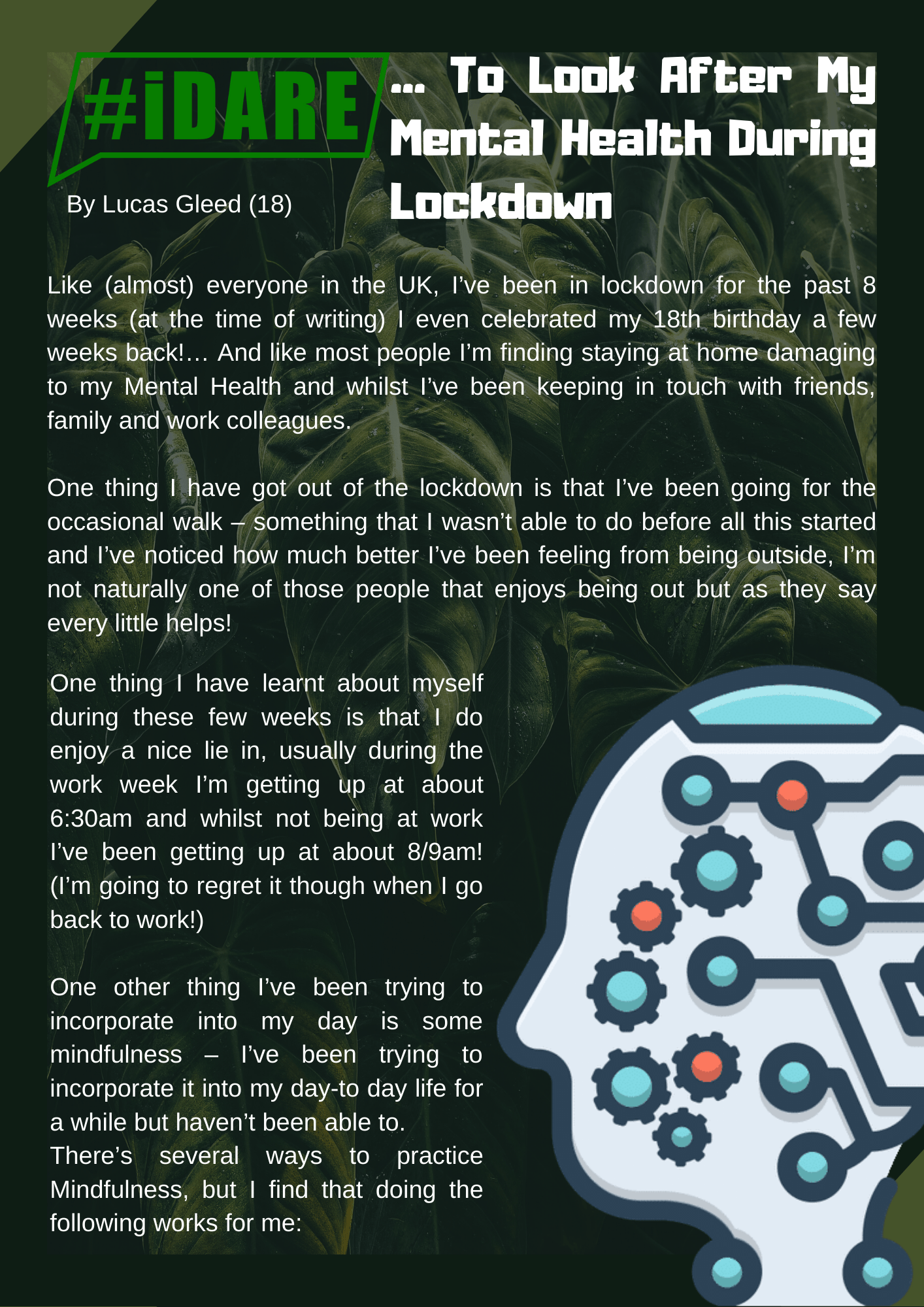#iDare Blog: By young people, for young people
Looking After My Mental Health and Mindfulness During Lockdown
Lucas Gleed (18) • 7 June 2020
#iDareToLookAfterMyMentalHealth

Like (almost) everyone in the UK, I’ve been in lockdown for the past 8 weeks (at the time of writing) I even celebrated my 18th birthday a few weeks back!… And like most people I’m finding staying at home damaging to my Mental Health and whilst I’ve been keeping in touch with friends, family and work colleagues.
One thing I have got out of the lockdown is that I’ve been going for the occasional walk – something that I wasn’t able to do before all this started and I’ve noticed how much better I’ve been feeling from being outside, I’m not naturally one of those people that enjoys being out but as they say every little helps!
One thing I have learnt about myself during these few weeks is that I do enjoy a nice lie in, usually during the work week I’m getting up at about 6:30am and whilst not being at work I’ve been getting up at about 8/9am! (I’m going to regret it though when I go back to work!)
One other thing I’ve been trying to incorporate into my day is some mindfulness – I’ve been trying to incorporate it into my day-to day life for a while but haven’t been able to. There’s several ways to practice Mindfulness, but I find that doing the following works for me:
Remember: The goal of mindfulness is to wake up to the inner workings of our mental, emotional, and physical processes.
1. Take a seat. Find a place to sit that feels calm and quiet to you. I find sitting in my bedroom on my bed easier and quieter during the day, I did try outside but got interrupted by Cars going past and noisy neighbours cutting their grass!!
2. Set a time limit. If you’re just beginning, it can help to choose a short time, such as 5 or 10 minutes. I tend to stick to 5 to 10 mins as I’ve usually got a busy schedule so it helps me stick with it.
3. Notice your body. You can sit in a chair with your feet on the floor, you can sit loosely cross-legged, in lotus posture, you can kneel—all are fine. Just make sure you are stable and, in a position, you can stay in for a while. I find kneeling on a pillow helpful (if outside) , Or if inside I find sitting cross-legged on the bed easier.
4. Feel your breath. Follow the sensation of your breath as it goes out and as it goes in.
5. Notice when your mind has wandered. Inevitably, your attention will leave the sensations of the breath and wander to other places. When you get around to noticing this—in a few seconds, a minute, five minutes—simply return your attention to the breath. I usually get distracted by my thoughts wandering off to other work I’ve got to do before the day is up – if I find myself thinking like this I can’t then un-think it! So I stop the session for the day – I’ll just try and fit one in before I go to bed.
6. Be kind to your wandering mind. Don’t judge yourself or obsess over the content of the thoughts you find yourself lost in. Just come back.
(Taken from www.Mindful.org)
Whilst doing a bit of research for this article I came across another mindfulness ‘Meditation’ Practice:
A Simple Meditation Practice
1. Sit comfortably. Find a spot that gives you a stable, solid, comfortable seat.
2. Notice what your legs are doing. If on a cushion, cross your legs comfortably in front of you. If on a chair, rest the bottoms of your feet on the floor.
3. Straighten your upper body—but don’t stiffen. Your spine has natural curvature. Let it be there.
4. Notice what your arms are doing. Situate your upper arms parallel to your upper body. Rest the palms of your hands on your legs wherever it feels most natural.
5. Soften your gaze. Drop your chin a little and let your gaze fall gently downward. It’s not necessary to close your eyes. You can simply let what appears before your eyes be there without focusing on it.
6. Feel your breath. Bring your attention to the physical sensation of breathing: the air moving through your nose or mouth, the rising and falling of your belly, or your chest.
7. Notice when your mind wanders from your breath. Inevitably, your attention will leave the breath and wander to other places. Don’t worry. There’s no need to block or eliminate thinking. When you notice your mind wandering gently return your attention to the breath.
8. Be kind about your wandering mind. You may find your mind wandering constantly—that’s normal, too. Instead of wrestling with your thoughts, practice observing them without reacting. Just sit and pay attention. As hard as it is to maintain, that’s all there is. Come back to your breath over and over again, without judgment or expectation.
9. When you’re ready, gently lift your gaze (if your eyes are closed, open them). Take a moment and notice any sounds in the environment. Notice how your body feels right now. Notice your thoughts and emotions.
You might find some Music Helpful whilst you practice your mindfulness, here’s a Playlist I’ve been using on Spotify:
I really hope that performing some Mindfulness helps you as much as it’s helping me!
Magazine Pages:
Have a look at the Spotify Playlist here:














